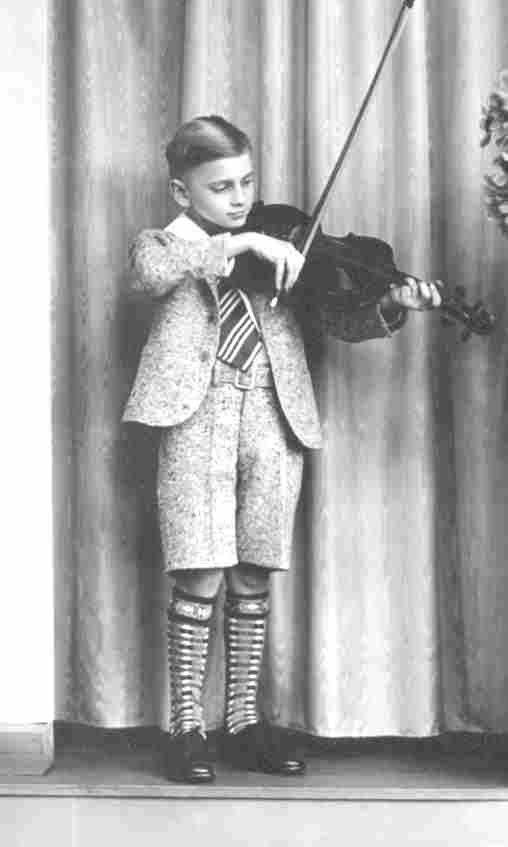
Boys' Recital and Performance Clothes during the Inter-War Years: Short Pants Suits (1920-45)

Figure 1.--This American boy wears an Eton collar with his short pants suit. He wears a matching belt. Note the patterned kneesocks which seem rather out of place with an Eton colar. They look like the kneesocks normally worn with knickers. European boys would be more likely to wear solid colored kneesocks. The photograph was taken in Chicago, Illinois, probably taken about 1935.
|
Short pants suits appeared in the 1910s and had become quite common in Europe,
but less so in America during the 1920s. Short pants were worn year round by British and
some other European boys, but were more seasonal in America. They became somewhat
more common in America during the 1930s, but for younger boys. They were very
often worn with short ankle socks rather than kneesocks. Boy during the summer
might wear their suit jackets with white or light-colored short pants. Ankle socks
were particularly common in the summer. Younger boys in America might wear
Eton suits, lapelless jackets worn with Eton collars.
Chronology
Boys do not begin wearing short pants suits commonly until the 1920s. Previously knicker and kneepants suits were more common. Chrnological trends vary by country.
Country Differences
Short pants suits appeared in the 1910s and had become quite common in Europe,
but less so in America during the 1920s. Short pants were worn year round by British and
some other European boys, but were more seasonal in America. They became somewhat
more common in America during the 1930s, but for younger boys.
Suit Styles
Most boys wore suits to their reciatals. Younger boys might wear Eton suits. Older boys wore suits rather like their fathers, except for the pants. The length of the short pants varied substantuially. This depended on the period, country, and mother's preferences.
Eton Suits
Younger boys in America might wear Eton suits, lapelless jackets worn with Eton collars. These were concervative rather formal suits. While mostly younger boys wore the Eton suits to recitals, many older boys, especially in the 1920s, might wear an Eton collar with their suits for formal recitals.
Single Breasted
Single breasted suits were the most common. Suits had a number of stylistic differences. Some had matching belts made out of the same material as the suit. Lapels could be quite wide. Single colored suits were generally wornnto recitals, but sports jackets with different coloted pants begin to appear by the late 1930s.
Double Breasted
Double breasted sduits were also wornnby boys, but not as commonly as single breasted styles.
Other Clothing
Some of the other clothing worn with short pants suits at recitals include.
Ties
Most boys wore adultvlooking ties, although some younger boys still wore bows in the eraly 1920s. Both bowties and neckties were worn. The neckties could be quite wide. Boys by the 1930s might wear open collared shirts with their suits.
Socks
They were very
often worn with short ankle socks rather than kneesocks. Boy during the summer
might wear their suit jackets with white or light-colored short pants. Ankle socks
were particularly common in the summer, especially in America.
Christopher Wagner

Navigate the Historic Boys' Clothing Web Site:
[Return to the Main inter-war years suit instrumental music page]
[Introduction]
[Activities]
[Bibliographies]
[Biographies]
[Chronology]
[Clothing styles]
[Contributions]
[Boys' Clothing Home]
Related Chronolgy Pages in the Boys' Historical Web Site
[Main Chronology Page]
[The 1900s]
[The 1910s]
[The 1920s]
[The 1930s]
[The 1940s]
[The 1950s]
[The 1960s]
Navigate the Historic Boys' Clothing Web style pages:
[Kilts]
[Caps]
[Sailor suits]
[Short pants suit]
[Kneesocks]
[Sailor hats]
[School uniform]
[Scout]
Created: June 15, 2000
Last updated: June 15, 2000



